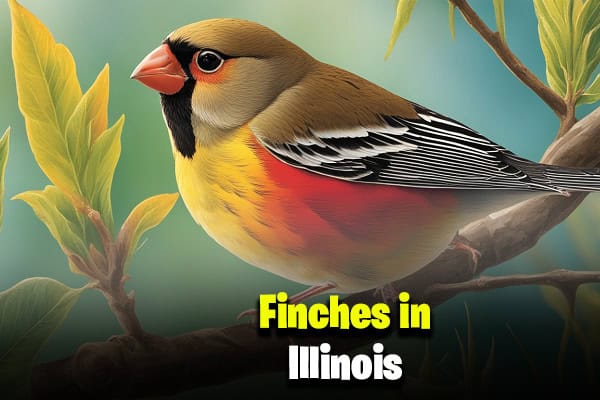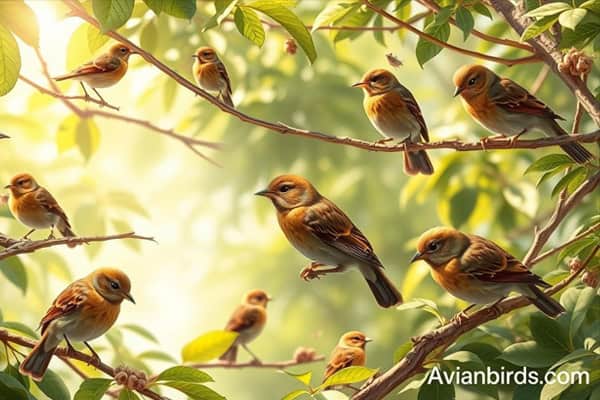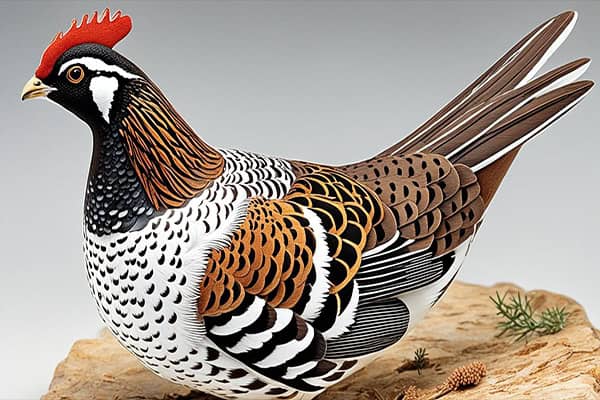7 Types Of Finches in Illinois (ID Guide With Pictures)
Ever wondered about the Finches living in Illinois? Finches are a key part of this bird community. They come in many types, each with its traits and behaviors. We aim to spark a love for birdwatching and connect us more with Illinois’ nature.
This guide will focus on the seven main finch species in Illinois. By learning to spot these birds, we can understand their importance in nature. Let’s explore the world of finches in Illinois and see what makes each one unique!
Introduction to Finches
Finches are small to medium-sized birds that catch the eye with their bright colors and social nature. They often gather in large groups, making them easy to spot at backyard feeders. In Illinois, many finch species live, each with its own unique traits.
Birdwatchers enjoy spotting different finches, like the American Goldfinch and the Pine Siskin. Watching how they interact and eat helps us appreciate these birds more. It shows their important role in nature.
Habitat and Distribution of Finches in Illinois
Illinois is a key spot for finches, being the southern end of their winter migration path. This makes it a great place for bird-watching. The state’s unique location brings many finches to the area.
In northern Illinois, there are many Illinois bird habitats where finches are often seen. These include:
- Weedy fields
- Parks
- Gardens
- Coniferous forests
Finches like these places for nesting and finding food. Exploring these spots helps us appreciate Illinois’s bird life more. Knowing where finches live makes bird watching in Illinois exciting.
1. American Goldfinch
The American Goldfinch is known for its bright colors and beautiful song. It’s a common sight in gardens and parks. Learning about its looks, eating habits, and how it breeds helps us enjoy its presence more.
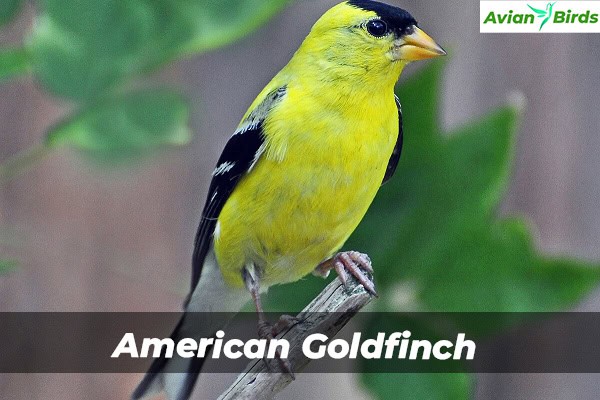
Identification and Characteristics
When we see an American Goldfinch, its bright yellow color stands out. Males shine in summer with black wings and a black head cap. Females are less bright, especially in the breeding season. Knowing these differences helps us spot them in Illinois.
Diet and Feeding Habits
American Goldfinches love to eat seeds from sunflowers, asters, and grasses. They hang out in weedy fields, gardens, and open spots where food is easy to find. Watching them feed is a joy. Their eating habits show how they adapt to different places.
Breeding and Nesting Behavior
American Goldfinches start breeding in late July, later than many birds. This lets them use seeds at their best. They build nests in shrubs or trees, using plants and spider silk. The nest is a safe place for the mom to care for her babies. Watching them during the nesting season is interesting.
2. House Finch
The House Finch is a bird we often see in our neighborhoods. It’s known as Haemorhous mexicanus. These birds are easy to spot because of their bright colors and behaviors. They live well in cities and suburbs.

Identification and Characteristics
Male House Finches stand out with their reddish heads, necks, and breasts. Females have streaked brown feathers. This color difference helps us tell males from females. Both have a short tail and sharp beak, perfect for eating.
They are about 5 to 6 inches long. This size makes them easy to see as they move around.
Diet and Feeding Preferences
The House Finches in Illinois eat seeds, buds, and berries. They love seeds, so they often visit bird feeders. This helps them live well in Illinois, where they find plenty of food.
We see them in our yards, showing how social and lively they are.
Habitat and Range
House Finches live in many places, showing how adaptable they are. You can find them in cities, gardens, and parks. They are common in Illinois and many parts of North America.
Their ability to live in different places means we can see them in both cities and the countryside.
| Attribute | Description |
|---|---|
| Scientific Name | Haemorhous mexicanus |
| Size | 5 to 6 inches |
| Male Plumage | Reddish on the head, neck, and breast |
| Female Plumage | Streaked brown |
| Diet | Seeds, buds, berries |
| Common Habitats | Urban areas, gardens, parks |
3. Pine Siskin
The Pine Siskin, known scientifically as Spinus pinus, is a small finch that captures our hearts. It’s important to know how to spot and understand the Pine Siskin. Their unique social behavior makes them fun to watch in different places.

Identification and Physical Traits
Spotting the Pine Siskin is easy once you know what to look for. They have a brownish color with streaks and faint yellow on their wings. Both males and females look similar, making them a bit tricky to tell apart. But, listen for their special sounds to confirm their identity.
Social Behavior and Feeding
The social life of the Pine Siskin is quite interesting. They love to be in big groups, especially when they’re eating. You can find them in forests or even in your backyard garden. They enjoy eating seeds like sunflower and Nyjer seeds. Setting up a feeder can be a great way to watch these finches up close.
4. Purple Finch
The Purple Finch, known as Haemorhous purpureus, is a favorite among bird lovers in Illinois. Its bright colors make it easy to spot, especially for those who enjoy watching finches in nature.
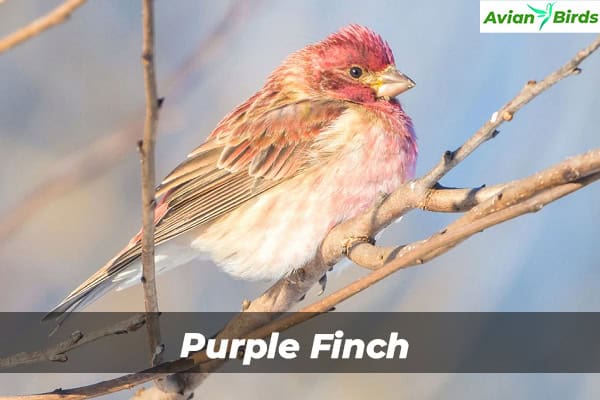
Identification and Characteristics
The male Purple Finch stands out with its deep raspberry color. This is a stark contrast to the brown feathers of the female. In the off-season, their colors change based on their surroundings. Their size and unique beaks also help us tell them apart.
Breeding Behavior and Habitat
Spring is when the Purple Finch starts to breed. Males show off their bright colors and singing skills to find a mate. They build their nests in evergreen trees, keeping their babies safe.
In winter, these finches look for seeds to eat. But they eat insects and plants too in other seasons. This flexibility helps them survive in Illinois all year round.
5. Evening Grosbeak
The Evening Grosbeak, known as Hesperiphona vespertina, stands out among finches. They are big and colorful, with eating habits that make them a vulnerable species.

Identification and Size
Identifying the Evening Grosbeak is easy due to its size. Males shine with bright yellow feathers and black wings. They also have a black cap that makes them look unique. Females are less bright but still have a strong bill for eating hard seeds.
Dietary Preferences
These birds love to eat seeds from trees like maple and locust. Their strong bills help them get to these seeds easily. They also eat fruits and flowers, making their diet varied.
Vulnerability Status
The Evening Grosbeak is sadly a vulnerable species. Losing their homes is a big threat to them. We need to help protect their homes so these beautiful birds can keep living.
| Characteristic | Male | Female |
|---|---|---|
| Plumage Color | Bright yellow with black | Brown and yellow |
| Size | Larger than average finch | Larger than average finch |
| Diet | Seeds (maple, locust) | Seeds (maple, locust) |
| Status | Vulnerable | Vulnerable |
6. White-Winged Crossbill
The White-Winged Crossbill, known as Loxia leucoptera, is a fascinating bird for birdwatchers. It’s known for its special crisscross beak. This beak helps it get seeds out of conifer cones. Learning how to spot the White-Winged Crossbill can make birdwatching in northern Illinois more exciting.

Identification and Characteristics
Males of the White-Winged Crossbill have bright reddish feathers and white wing bars. These features make them stand out from other finches. Their unique beak lets them get to seeds that others can’t. Listening for their distinct call can also help us identify them.
Breeding Habits and Diet
This bird changes its breeding times based on food availability. They mainly eat conifer seeds. This makes them rely on healthy pine and spruce forests. Watching how they eat can teach us more about their role in nature.
Finches in Illinois: Seasonal Observations
Seasonal observations are key to understanding Illinois finches. Throughout the year, we see different patterns. These patterns are due to changes in temperature, food, and habitat.
In warmer months, many finches come to Illinois to breed. This makes birdwatching exciting for enthusiasts.
Spring brings a burst of finches as they return from their winter migration. The American Goldfinch and House Finch are often seen in gardens and feeders. Watching them during this time is rewarding, as we see courtship and nesting.
As summer turns to fall, finches start to move south or prepare for winter. Keeping up with these changes helps us know when to look for specific finches. This makes birdwatching more enjoyable.
Winter presents its own challenges and rewards. Finches like the Pine Siskin and Evening Grosbeak may be harder to find. We need to adjust our birdwatching to spot them in the snow.
By tracking these seasonal trends, we improve our birdwatching. Watching Illinois finches through the seasons connects us to nature. It also deepens our love for birds.
Related Video:
Best Practices for Attracting Finches
To attract finches, we can use a few smart strategies. Choosing the right bird feeders is key. Feeders made for Nyjer seeds or thistle are great choices. Fill these with a mix of sunflower and Nyjer seeds, as finches love them.
It’s also important where we put our bird feeders. Place them in open spots but keep them safe from predators. Adding plants like shrubs or trees gives finches a place to hide and look good in our yard.
Keeping the area clean is crucial for finches to visit often. Remove old seeds and debris to make a clean spot for them. This way, we can watch many finch species in our backyard.
Here’s a quick overview of the essentials to attract finches effectively:
| Practice | Description |
|---|---|
| Feeders | Use specialized feeders for nyjer seeds and sunflower seeds. |
| Location | Position feeders in open spaces, away from predator reach. |
| Natural Cover | Incorporate shrubs or trees for shelter and protection. |
| Maintenance | Regularly clean the feeding area to promote hygiene. |
By following these tips, we can make our yards welcoming for finches. This will make our backyard birdwatching even better. Enjoy watching these beautiful birds in our own yards!
Understanding Finch Social Behavior
Finches love to live together in groups, which is a key part of their life. This social behavior helps them find food and stay safe from predators. Living in flocks makes it easier for them to spot where food is and keeps them safe.
Finches talk to each other a lot, using different sounds for different things. They might call out to warn others of danger or to find a mate. Learning what these sounds mean helps us enjoy watching them more.
Watching finches together shows how close they are. They move and act together, showing they feel like family. This teamwork is crucial for their survival and daily life.
Common Threats to Finch Populations
Finches in Illinois face many threats that put their survival at risk. Habitat loss from urban growth is a big issue, as it takes away the places they need for living and finding food. Climate change also changes their migration paths and food sources.
Domestic animals, especially cats, prey on finches, further reducing their numbers. These threats lead to a decline in finch populations. It’s crucial to understand these issues to help protect them.
We can help by supporting local birdwatching groups and volunteering for bird conservation. We should also push for responsible pet ownership to lessen the danger to finches.
- Support local birdwatching programs.
- Volunteer with organizations dedicated to bird conservation.
- Advocate for responsible pet ownership to minimize threats to finches.
Together, we can make a big difference. By spreading the word about the dangers to finches and joining conservation efforts, we can help these beautiful birds survive in the future.
Finches in Other Regions:
Wrapping Up…
As we wrap up our look at Illinois finches, we see how important they are to our ecosystems. Each type, like the American Goldfinch and the Evening Grosbeak, adds something special to our birdwatching adventures. By learning about their lives and where they live, we grow closer to these birds.
Finches face big challenges, like losing their homes and finding less food. This makes us want to help protect them. By making places safe for birds and supporting conservation, we can make a difference. This way, our kids and grandkids can also enjoy watching finches in our yards and parks.
In the end, the beauty of Illinois finches is more than just their looks and sounds. It’s about the bond we feel with nature. Let’s work together to keep these birds around. By doing so, we ensure they will continue to brighten our lives for years to come.

